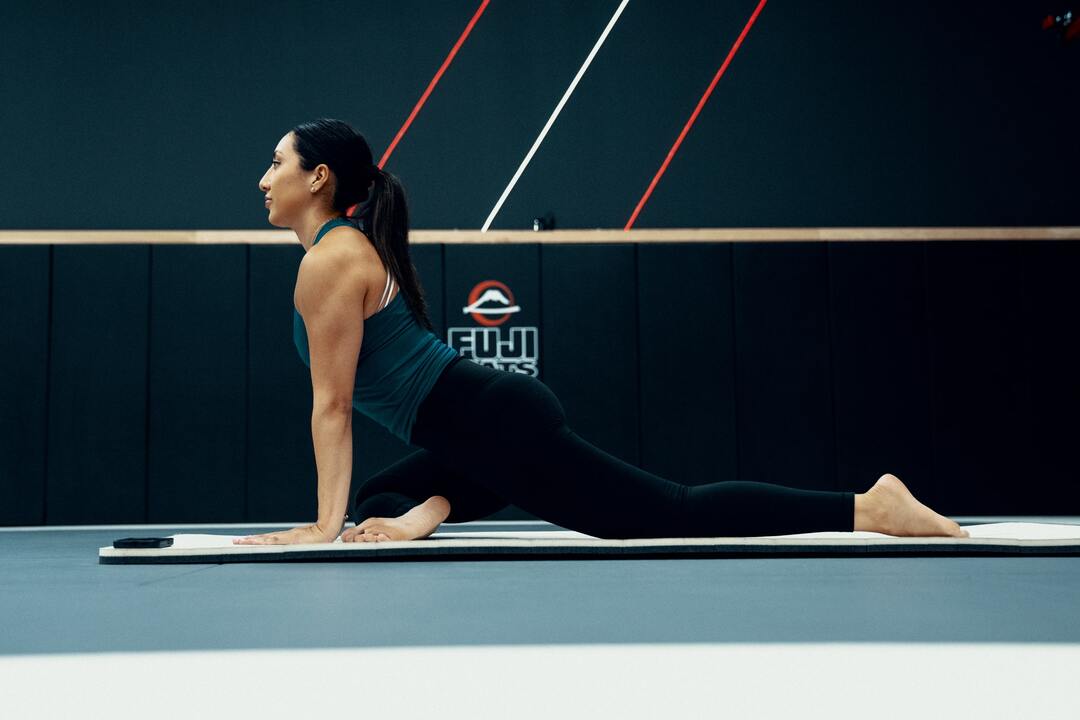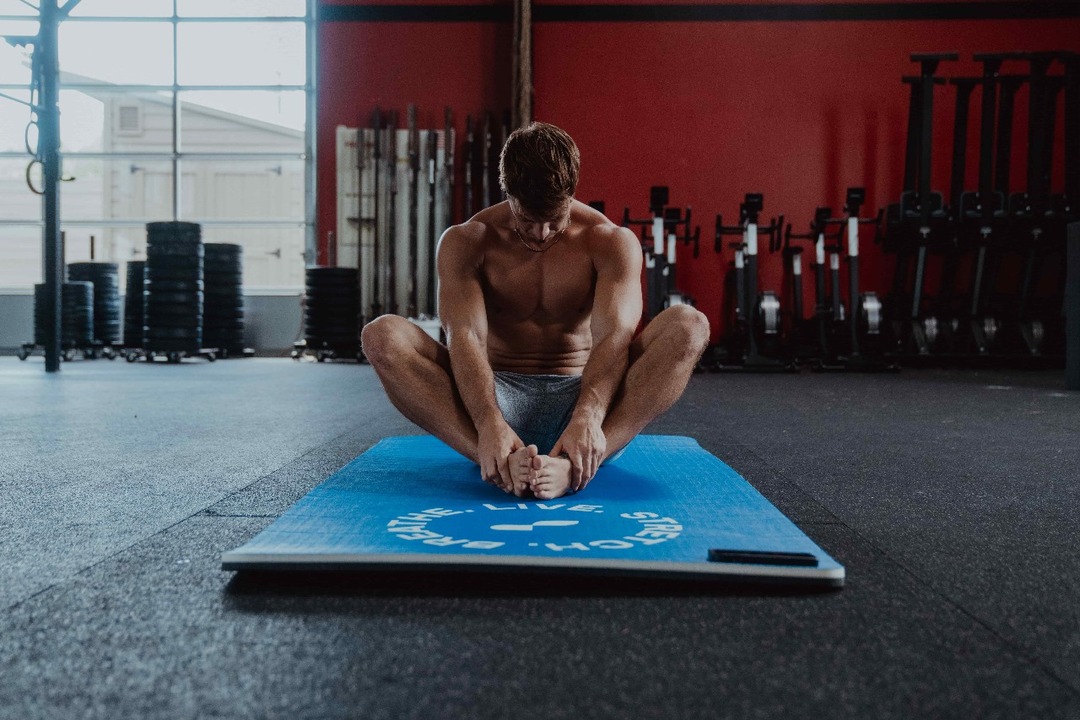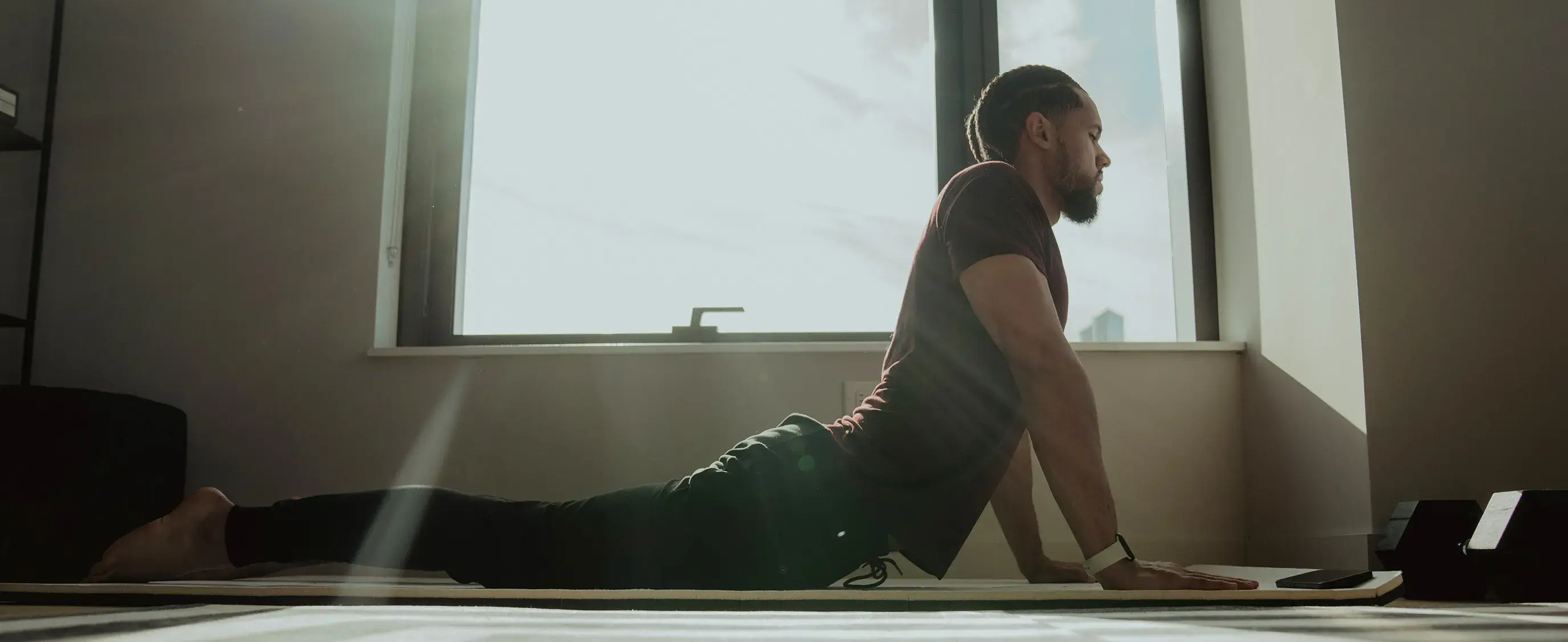You know that tight pull across your lower back after standing at a counter or at a standing desk, suddenly, small tasks feel stiff and slow. In Stretching Routines for Stiffness, this common problem is significant because it restricts posture, walking, and everyday movement. How to loosen tight lower back muscles while standing outlines simple standing stretches, spinal mobility drills, hip and hamstring releases, and easy self-massage moves, allowing you to quickly and effortlessly relieve lower back tightness while standing, feel comfortable, move freely, and stay active without pain holding you back.
To make that practical and fast, Pliability's mobility app offers guided standing routines, clear cues, and short progressions you can use anywhere to restore range of motion and ease.
What Causes Tight Lower Back Muscles?
-min.jpg)
Tightness in the lower back often comes from simple, everyday stresses on the muscles and joints. Muscle strain from a single awkward lift and poor posture from prolonged periods of sitting both load the lumbar muscles and cause them to shorten. Weak core muscles require the back to work harder to maintain an upright position.
Tight hips and hamstrings change the angle of your pelvis and pull on the lumbar spine. Repetitive movements at work or during exercise produce small amounts of wear and tear that accumulate over time. Stress and anxiety also play a role. When you are tense, your back muscles contract and hold that contraction, which increases the sense of stiffness.
Inside the Lower Back: The Anatomy You Need to Know
The lower back is situated in the lumbar region, comprising five vertebrae labeled L1 through L5. These bones support the upper body and allow bending and twisting. Large muscles, such as the erector spinae, run along either side of the spine and help you stand and extend your trunk. Smaller stabilizers, like the multifidus, sit closer to the vertebrae and control segmental motion.
The quadratus lumborum plays a role in side bending and pelvic control. Between the vertebrae, the intervertebral discs act as shock absorbers; if a disc herniates or wears down, it can press on nearby nerves, causing pain or a feeling of tightness. Ligaments and tendons link bones to each other and muscles to bones, and irritation of these tissues can trigger guarding and stiffness.
Common Triggers That Tighten Your Lower Back
Slouching shifts the load to the discs and makes some muscles overwork while others weaken. When you lean forward at a desk or crane your neck toward a screen, the lumbar muscles must hold the trunk in a suboptimal position. Over time, those muscles tighten to protect the spine, and flexibility drops.
Lack of Movement and Weak Core: What Deconditioning Does
When you do not move enough, muscles lose length and strength. The deep abdominal and pelvic floor muscles are designed to stabilize the spine; if they are weak, the lower back bears a greater load during activities such as lifting, walking, and standing. Inactivity also shortens hip flexors and hamstrings, which changes pelvic tilt and increases lumbar stress.
Muscle Strain: When Fibers Get Stretched Too Far
Strains happen when muscle fibers are overstretched or overloaded. Lifting with a rounded back or twisting while carrying weight commonly causes strain. The injured muscle responds with inflammation and tightness. That protective tightness limits movement and keeps the area guarded until healing progresses.
Injuries and Trauma: Falls, Accidents, and Sports
A fall, collision, or sudden impact can stretch ligaments, sprain joints, or damage discs. Even minor injuries can trigger prolonged muscle guarding around the injured area. That guarding raises muscle tone and produces persistent stiffness during daily tasks.
Hip and Hamstring Stiffness: How Nearby Muscles Pull on the Back
Tight hip flexors tilt the pelvis forward and increase the lumbar curve. Tight hamstrings pull the pelvis back when you bend, which can stress the lower back during forward bending. When hips and hamstrings lack flexibility, the lower back compensates with extra movement and stiffness.
Repetitive Movements and Overuse: Small Actions That Build Tension
Repetitively turning, bending, or lifting in the same pattern places the same tissues under stress. Overuse produces microtrauma, small-scale inflammation, and adaptive tightening of muscles and connective tissue. Changing movement patterns and adding variety often reduces that accumulated tension.
Stress and Muscle Guarding: How Tension Locks Muscles
Emotional stress triggers the sympathetic nervous system, increasing baseline muscle tone. The lower back is a shared place for that holding pattern. Muscles remain partially contracted, blood flow reduces, and the area feels stiff and sensitive. Simple breathing and relaxation techniques can reduce this guarded state.
Stand and Release: How to Loosen Tight Lower Back Muscles While Standing
Try these standing releases and mobilizations. Move slowly and stop if you feel sharp or shooting pain. Aim for controlled sets of 6 to 12 reps, breathe evenly, and repeat a few times a day.
Standing Lumbar Extension
Stand with feet hip-width apart. Place your hands on your lower back for support, press into your heels, and gently arch your spine backward while lifting your chest. Pause for one breath, then return to neutral. This opens the front of the spine and counteracts prolonged flexion.
Standing Forward Bend with Soft Knees
Hinge at the hips, let the torso fold over slightly, with the knees bent, and allow the hips to release. Keep weight in the heels and soften the neck. This helps unload the lumbar spine and stretches hamstrings without forcing them.
Standing Hamstring Release against a Step
Place one heel on a low step or curb, toes pointing up. Keep a slight bend in the standing knee and hinge forward from the hips until you feel a gentle stretch behind the thigh. Switch sides. This reduces hamstring pull on the pelvis.
Standing Hip Flexor and Pelvic Tilt
Take a staggered stance with one foot forward and the other back. Shift your weight forward, drop the back knee slightly, and tuck the pelvis under to feel the front of the hip release. Combine the tilt with a slow breathing cycle to ease lumbar tension.
Standing Spinal Twist
With feet shoulder-width apart, rotate your upper body to one side while keeping your hips square. Reach across with the opposite hand to gently increase the rotation. Use your core to return to center. This promotes spinal mobility and loosens rotational stiffness.
Dynamic Standing Cat Cow
Place hands on thighs. Inhale and lift the chest while letting the belly drop slightly toward the thighs for a gentle extension. Exhale and round the spine, tucking the chin. Move with breath for several cycles to mobilize the entire spine while standing.
Gentle Standing Side Bend
Reach one arm overhead and lean toward the opposite side, keeping hips stable. This targets the quadratus lumborum and side stabilizers that often hold tension.
Practical Tips While You Stand
Activate your core gently by drawing the belly button toward the spine; this provides immediate support without bracing. Change position every 20 to 30 minutes during long-standing or sitting tasks.
Use controlled, repeated movements rather than forcing a single deep stretch. If pain radiates into your leg, causes numbness, or limits your ability to walk, seek professional assessment.
Related Reading
- Why Do I Have Trouble Walking After Sitting
- Why Am I Sore After Stretching
- What Do Tight Muscles Look Like
- Why Do Muscles Get Tight
- Why is Hip Mobility Important
- How Can Stiff and Tight Muscles Result in Back Pain?
- Why is My Back So Stiff
- Why Are My Shoulders So Tight
- How to Prevent Morning Stiffness
How to Loosen Tight Lower Back Muscles While Standing
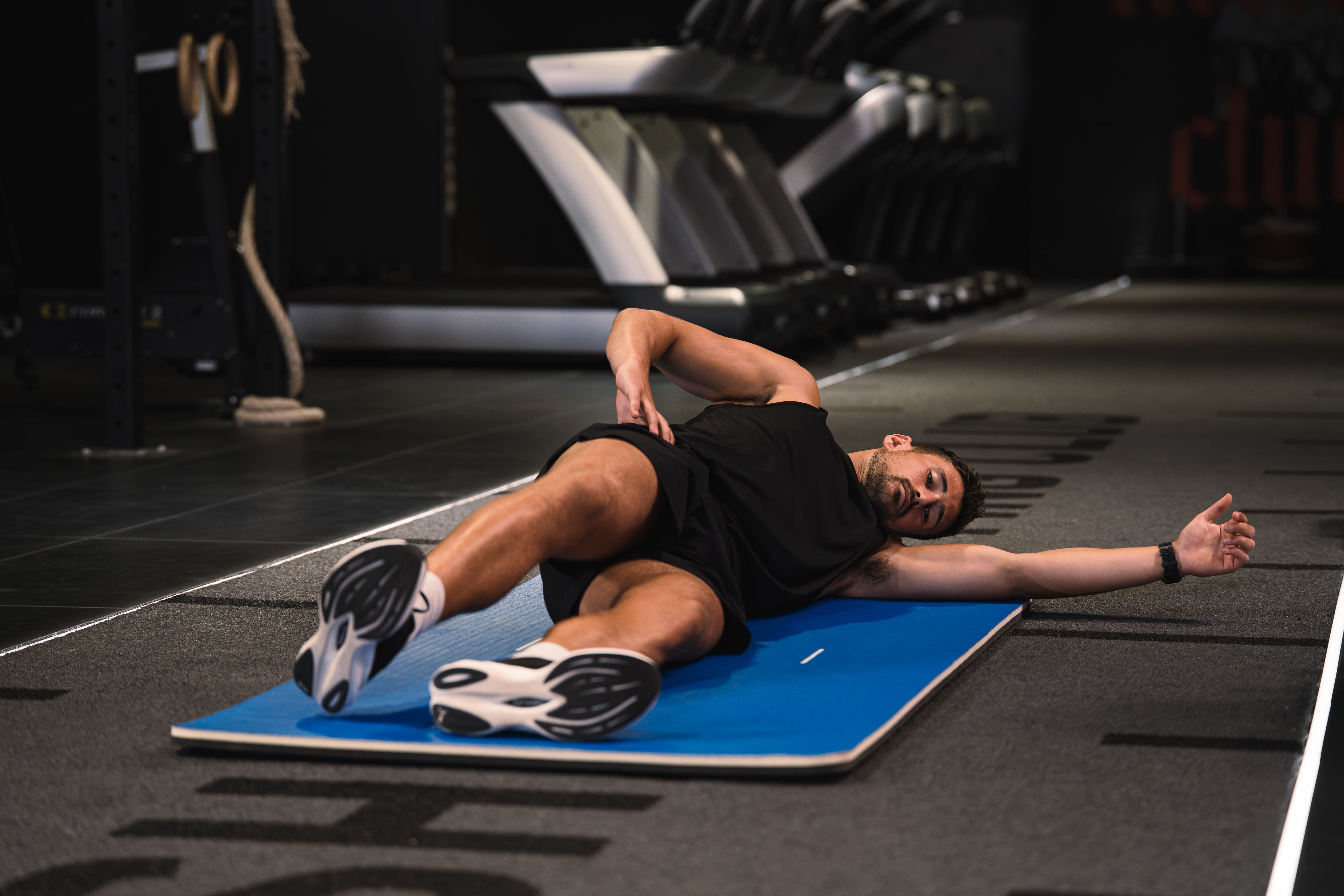
Begin with 3 to 5 minutes of gentle movement to increase blood flow and loosen your joints. March in place, swing your arms, or walk around the room. Move steadily and breathe deeply while you warm up. Stop if you feel sharp pain and rest.
Quick Gentle Standing Moves You Can Do Anytime
Try these short, safe moves without special equipment.
Hands on Hips and Gentle Arch
Place your hands on your hips and stand with your feet shoulder-width apart. Inhale, lift your chest slightly, and arch your back somewhat backward, only as far as feels comfortable. Exhale and return to neutral. Repeat slowly 5 to 8 times.
Slow Torso Twists
Stand with feet slightly apart, knees soft, and arms relaxed. Keep your hips facing forward and gently twist your torso to the right, then back to center, then to the left. Breathe evenly and move slowly for 10 repetitions per side.
Standing Hamstring Prop
Place one foot on a low step, chair seat, or stair so that your knee remains slightly bent. Hinge at the hips with a straight spine and reach toward your shin or ankle until you feel a gentle stretch in the back of the thigh. Hold 15 to 30 seconds and switch sides.
Seated Trunk Rotation: A Safe Entry for Stiffer Backs
If you can stand comfortably, skip this and use the standing rotation below.
- Sit in a firm chair with your feet flat and your knees at a 90-degree angle. Lean forward slightly so your back is not resting against the chair back. Cross your arms across your chest.
- Keep your hips facing forward at all times.
- Slowly rotate your torso to the right as far as feels comfortable, then return to center. Rotate to the left the same way.
- Repeat 10 times on each side, moving slowly and breathing naturally.
Standing Trunk Rotation: Regain Lumbar Rotation While Standing
- Stand tall with feet slightly apart and knees soft. Cross your arms across your chest.
- Keep your hips squared forward and rotate your upper body to the right, then return to center and rotate to the left.
- Move slowly and control the motion. Do 10 rotations on each side and note any side that feels stiffer.
High Knees: Hip Flexor and Low Back Mobility With Balance Work
- Stand tall with feet slightly apart.
- Slowly lift your right knee toward hip level or as high as you can, then lower gently.
- Repeat with the left knee. Do 10 lifts per side.
- If your balance feels weak, hold onto the back of a chair or a counter, and have someone nearby in case you need extra support.
Standing Side Bends: Open the Obliques and Lower Back
- Stand with feet shoulder-width apart and arms relaxed at your sides.
- Keeping the body in a straight line, slide your right hand down your right leg toward the knee as you bend to the right. Reach only as far as comfortable.
- Come back up and repeat on the left side.
- Perform 10 bends per side, keeping your hips steady as you move.
Standing Back Stretch: Safe Spinal Flexion While Standing
Do not do this if you have balance issues.
- Stand with feet shoulder-width apart.
- Hinge forward from the hips and let your upper body hang, rounding the back upward toward the ceiling while dropping your shoulders.
- Relax the muscles so it feels like the upper body is heavy and unsupported.
- Slowly roll back up to standing and repeat five times, moving with your breath.
Standing Forward Bend: Lengthen the Spine and Lower Back
- Stand with feet hip-width apart.
- Inhale and lift your arms overhead. Exhale as you hinge at the hips and fold forward.
- Let your arms hang naturally toward the floor or hold your opposite elbows for added comfort.
- Hold 15 to 30 seconds while breathing deeply and then rise slowly.
Standing L Stretch: Target the Lats and Mid to Lower Back
You will need something to hold up to about eye level.
- Place both hands on a bar, rail, countertop edge, or sturdy elevated surface at roughly eye level.
- Step back until your arms are straight and then hinge at the waist, keeping arms extended.
- You should feel a stretch under the armpits that runs down along the back toward the hips.
- Hold this position for about 30 seconds, breathing steadily, then release.
Standing Lumbar Rotation: Improve Spinal Twist While Staying Stable
- Stand with your feet about shoulder-width apart and keep your hips and feet steady.
- Slowly rotate your upper body to one side, using your ribs and chest to turn while keeping your pelvis facing forward.
- Start with a small range and increase as mobility improves. Repeat several slow rotations each way.
Standing Lumbar Rotation With Leg Behind: Bias One Side for Deeper Rotation
- Stand with your feet shoulder-width apart and step forward with one foot, placing the other foot slightly behind.
- Keep your feet and hips mostly steady, and rotate your torso away from the back leg as if turning to look over your shoulder.
- If balance feels tricky, widen your stance or stay near a wall or chair to grab if needed.
- Move slowly and repeat on both sides.
Cat Cow Stretch Standing Variation: Flow Spinal Flexion and Extension
- Stand with feet hip-width apart and knees soft.
- Inhale and allow the chest to lift, arching the back slightly as you draw the shoulder blades together.
- Exhale and round the spine, tucking the chin toward the chest.
- Cycle through 5 to 10 repetitions, breathing as you move to restore spine mobility.
Standing Spinal Twist: Hold and Breathe Into Rotation
- Stand with feet shoulder-width apart.
- Inhale, then exhale as you twist the torso to one side while keeping the hips forward.
- Optionally place one hand on your hip and extend the other behind for a fuller turn.
- Hold each twist for 15 to 30 seconds, then switch to the other side.
Knee to Chest Stretch Standing Variation: Pull the Lower Back Directly
- Stand tall with feet hip-width apart.
- Bend one knee and bring it up toward your chest while holding the shin or behind the thigh with both hands.
- Draw the knee toward the torso until you feel a gentle pull in the lower back and glute.
- Hold 15 to 30 seconds, then switch legs.
How to Move Slowly and Breathe While You Stretch
Move deliberately and keep breathing throughout every stretch. Inhale before you move into a new position and exhale as you settle into the stretch. If you experience any sharp or shooting pain, stop the movement immediately. Gentle tension is normal. Pain is not.
Safety Tips for Balance and Pain Avoidance
If you worry about falling, use a chair, countertop, or wall for support. Ask someone to stay nearby when you try a new stretch that challenges balance. Never force a range of motion. Avoid any stretch that causes pinching, numbness, or sharp pain in the back or down the leg.
Sample 10-Minute Standing Routine for Loosening Tight Lower Back Muscles
Follow this short sequence to target lumbar mobility and relieve lower back stiffness.
- Standing Forward Bend 15 to 30 seconds
- Standing side bends 10 per side
- Cat Cow standing 5 to 10 cycles
- Knee to Chest, standing 15 to 30 seconds per leg
- Standing trunk rotation 10 per side
- Standing L stretch 30 seconds per side
Practice this routine three to five times a week and add short versions during long periods of sitting.
How Small, Regular Stretches Help Your Lower Back
Short, consistent sessions increase blood flow, improve lumbar mobility, and reduce lower back stiffness over time, with effects lasting from a few days to several weeks.
Related Reading
- Stiff Feet in the Morning
- How Can Poor Posture Result in Back Pain?
- How Long Stiff Neck Last
- Stiff Feet in the Morning
- Why Does My Knee Feel Stiff
- How to Treat Stiff Fingers in the Morning
- Joint Stiffness in the Morning
- What to Do for Tight Muscles
- Why Are My Calf Muscles So Tight
- How to Loosen Tight Muscles in Legs
How Should I Stand to Relieve Lower Back Pain?
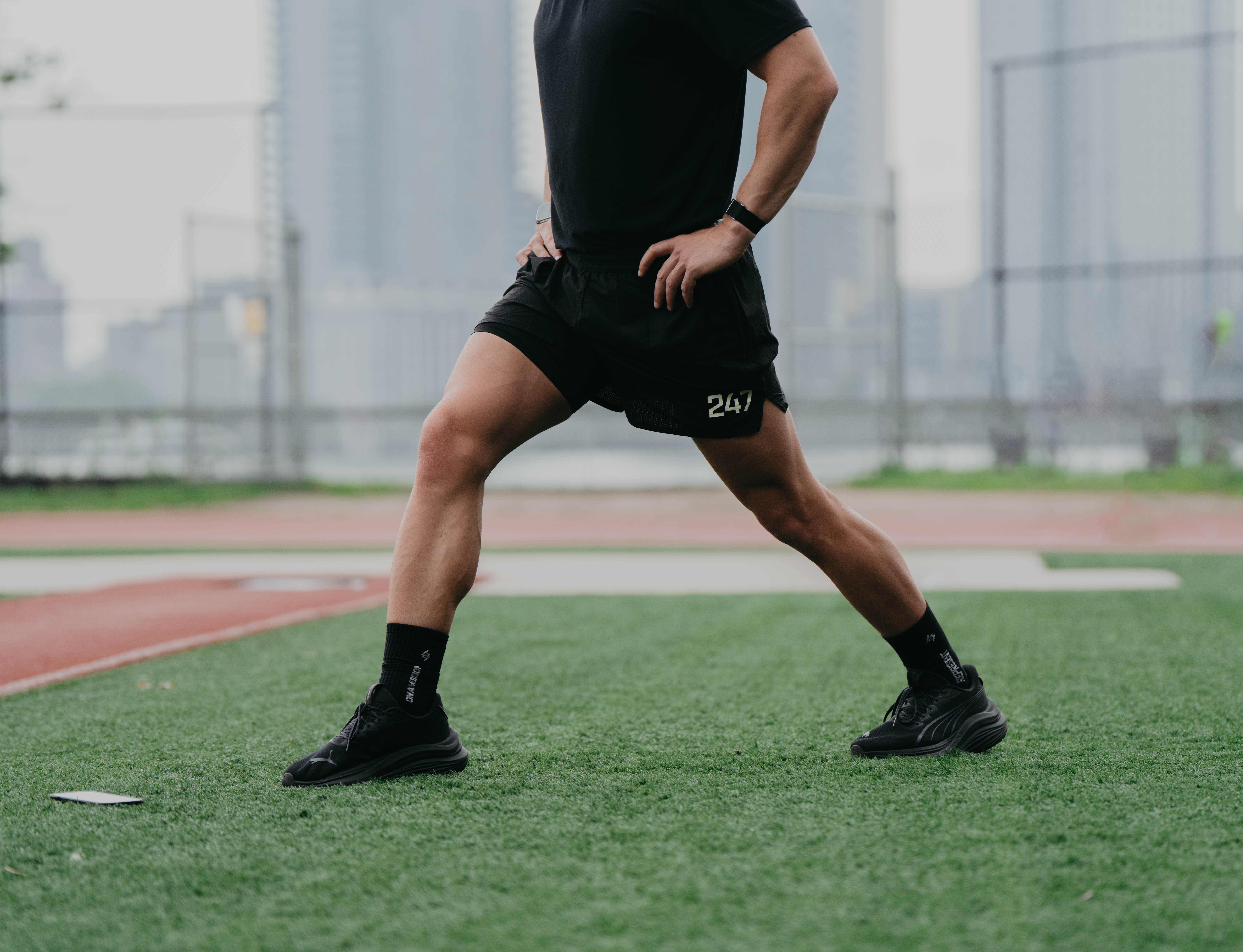
Stand with your feet about hip width apart, toes pointing forward. Relax your knees slightly so they are not locked. Let your shoulders relax down and back. Balance your weight evenly on both feet and feel the arches press gently into the floor.
Gently pull your lower belly in to engage your core and support your spine. Check that your head sits directly over your shoulders, not jutting forward. Avoid leaning to one side or slumping your rib cage forward.
Simple Micro Moves While Standing
Shift your weight slowly from one foot to the other every 30 to 60 seconds. If you stand for long periods, place one foot on a small footrest or step and switch feet every few minutes to prevent fatigue. Use micro moves to keep joints mobile while you stand:
- Ankle circles
- Tiny knee bends
- Gentle pelvic tilt
Hot or Cold: When to Use Heat and When to Use Ice on a Tight Lower Back
Use heat for chronic stiffness and general tightness. “Placing a warm compress on the lower back causes blood vessels to widen,” says Mary Descaro, physical therapist at Beaufort Memorial Outpatient Rehabilitation Services. For chronic conditions such as arthritis, heat decreases stiffness, improves blood flow, and relaxes muscles.
Use cold for recent strains or new injuries that show swelling and inflammation. For overworked or newly injured muscles, a cold compress constricts blood vessels and reduces inflammation in the affected area. Apply heat for 15-20 minutes and then ice for 10-15 minutes. Wrap packs in a thin towel and avoid direct skin contact. If you have diabetes or poor sensation, check with your provider before using hot or cold therapy.
Sit Up Straight, But Not for Too Long: Chair Setup and Movement Cues
Sit with your hips forming roughly a 90-degree angle and your feet resting flat on the floor. Choose a chair that supports the natural curve in your lower back. If your chair lacks lumbar support, place a small rolled towel behind your lower spine. Keep knees level with or slightly lower than hips.
Even perfect sitting becomes stiff over time. Tight hip flexors and hamstrings, often caused by prolonged sitting, can pull on the lumbar spine. Stand up, move, and stretch for a few minutes every 30 minutes when you can. Try a brief walk, standing cat cow, or single-leg shifts to restore blood flow and hip mobility.
Standing and Floor Stretches to Loosen a Tight Lower Back
Cat Cow and Standing Cat Cow
On all fours, hands under shoulders and knees under hips, inhale as you lower your belly and lift your head and tailbone. Exhale as you tuck the chin, pull the belly up, and round the back like an angry cat. Move slowly and breathe with the motion. Repeat five times.
If you cannot get on the floor, stand facing a counter. Place your hands on the surface, keep your elbows straight, and push through your hands as you arch your back. Then round your back by pressing your hips back and dropping your chest.
Modified Child Pose at a Counter
Stand a few steps back from a counter. Place both palms flat on the surface and walk your hands forward while hinging at your hips. Keep your torso, from hands to tailbone, flat like a table and hold for 5 to 10 seconds. Walk hands back and repeat three to five times.
Child Pose on the Floor
From hands and knees, sit back on your heels with knees apart and torso resting between your thighs. Extend arms forward or rest them at your sides. Rest forehead down if comfortable and breathe slowly for 30 seconds or longer.
Lying Trunk Rotation
Lie on your back with your knees bent and your feet flat on the floor. Arms out to the sides. Gently roll your knees to the left while keeping the opposite shoulder on the floor. Pause when you feel the belly and low back release for five to 10 seconds. Return to the center and repeat to the right. Do three to five reps on each side.
Prone Bridging Back Stretch and Upward Facing Dog
Lie on your stomach. Prop up on your elbows and lift your chest away from the floor. Slowly straighten your elbows as far as is comfortable, pushing your chest higher to extend your spine. Hold for 10 seconds and repeat up to 10 times.
For upward-facing dog, place your hands near your lower ribs and press up into straight arms, lifting your chest and shoulders while keeping your hips low. Breathe and lower with control.
Supine Abdominal Draw In and Supine Bridge
Lie on your back with knees bent and feet flat. Pull the lower belly toward the spine and press the small of the back into the floor. Hold for 10 to 30 seconds. Repeat three to five times.
For a supine bridge, press through the feet and lift your hips until your body forms a straight line from your shoulders to your knees. Squeeze the glutes, hold 10 to 30 seconds, and lower slowly. Repeat three to five times.
Seated Forward Curl and Seated Cat Cow
Sit tall in a firm chair, with your feet flat. Curl your neck, upper back, and lower back forward until your chest rests on your thighs, and your hands reach toward the floor. Hold for 10 to 30 seconds and slowly return to an upright position. Repeat three to five times.
Seated Cat Cow on a Chair
Sit 4 to 6 inches away from the backrest, with your hands on your thighs. On exhale, round forward, pulling the stomach in and chin to chest briefly. Inhale to arch back and look upward. Repeat with slow breaths for several cycles.
Side Stretch and Standing Trunk Rotations
Stand with feet shoulder-width apart. Slide your left hand down your thigh and reach your right arm over your head while leaning to the left. Hold 10 to 30 seconds, then switch sides. Repeat three to five times.
For rotation, stand with your feet slightly apart and extend your arms in front at shoulder height. Keep your hips facing forward and rotate your trunk slowly to the right and left. Breathe out on the twist and in as you return to the center. Add a light weight when the movement feels easy.
Knee Hugs and Knee Rolls
Lie on your back and hug both knees into your chest for five seconds and release. Repeat this exercise several times to help reduce lumbar tension.
For knee rolls, lie on your back with knees bent and arms out to the side. Slowly lower your knees to one side, keeping your feet together. Hold for one to two seconds, then return to the center and switch sides. Move slowly and breathe.
Superman and Prone Variations
Lie face down, arms extended. Exhale and lift the arms, chest, and legs off the floor while squeezing the glutes. Hold briefly and lower with control. If full reach is difficult, place your hands at your temples and lift your chest and legs.
Stretches for Lower Back Pain You Can Repeat Daily
Perform most mobility and stretch sequences gently, pausing where you feel a safe release. Aim for 3 to 5 repetitions for each stretch, or hold for 10 to 30 seconds, depending on your comfort level. Ask yourself which movements give you a genuine release and incorporate those into your routine.
Relax Your Mind to Relieve Your Tight Lower Back
High stress tightens the lumbar musculature. Try a short breathing break when tension spikes. Breathe in for four counts, hold briefly, and breathe out for six counts. Repeat five times. Take a two-minute walk outside to shift your nervous system.
Call a friend, write one sentence of gratitude, or stand quietly and notice your breath for three minutes. These simple actions lower sympathetic drive and help reduce muscle guarding.
Return to Your Core: Strength and Balance Moves That Reduce Lower Back Tightness
Loss of core strength changes balance and body awareness, and can lead to muscles tightening and overcompensating around the spine. Strengthen the deep abdominal and glute muscles while improving coordination.
Seated Good Mornings
Sit on a firm chair with your feet slightly wider than hip-width apart, and place your hands between your legs. Hinge at the hips, keeping the back straight, and lower your hands toward the floor. Return upright slowly. Aim for 8 to 12 repetitions.
Standing Good Mornings
Stand with feet shoulder-width apart, fingers at temples, core engaged. Hinge at the hips with a slight knee bend until your torso is near parallel to the floor. Keep a neutral spine and rise back up. Perform 8 to 12 controlled reps.
Pelvic Lift Hip Thrust
Lie on your back with knees bent. Exhale and lift the hips by engaging the core and glutes. Hold briefly and lower slowly. Start with 8 to 12 reps and progress by holding longer or performing single-leg variations.
Standing Trunk Rotations with Arms Extended
Stand tall and clasp hands at shoulder height. Keep hips square and rotate from the waist to feel a controlled pull across the torso. Perform 10 to 15 rotations in each direction. Add a light weight as you build strength.
Superman Progressions
Begin with small lifts of arms and legs. Progress to longer holds as back and glute control improve. Work with a clinician if pain or form is a problem.
How to Progress and Stay Safe
Begin with low reps and controlled tempo. If a movement causes sharp pain, stop and consult your healthcare provider. Ask about physical therapy, aquatic classes, or tai chi if you have arthritis or joint pain. A therapist can tailor core, balance, and mobility exercises to your specific needs and help you restore spinal stability while minimizing excess muscle tightness.
Improve Your Flexibility with Our Mobility App Today | Get 7 Days for Free on Any Platform
Pliability offers a fresh take on yoga, focusing on athletes and individuals seeking to enhance their performance. The app provides an extensive library of high-quality videos that teach flexibility drills, recovery flows, pain-reducing exercises, and range-of-motion routines. Daily updated custom mobility programs adapt to your unique movement patterns and how you feel.
A built-in body scan identifies stiff spots and asymmetries, allowing you to focus on the right area and do the right work. Use it alongside strength training, running, or team sports to enhance your movement without requiring additional gym time. Try seven days free on iPhone, iPad, Android, or on the web to test the videos, programs, and body scanning feature.
Related Reading
- Can Tight Hips Cause Knee Pain
- How to Loosen Tight Forearm Muscles
- Why Do My Legs Feel Tight and Heavy
- Why Does My Forearm Feel Tight
- What Causes Stiff Neck
- How to Loosen Tight Jaw Muscles
- Why Do My Hands Feel Tight
- How to Loosen Tight Hips and Lower Back
- How to Loosen Tight Scalp Muscles




